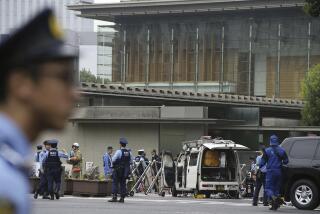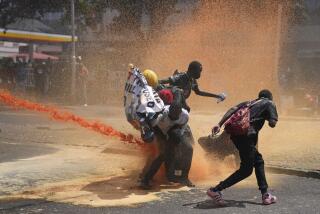Sri Lanka Fears Infiltration by Outlawed Group : Mysterious Sinhalese Extremists Suspected in Parliament Grenade, Gun Attack
- Share via
COLOMBO, Sri Lanka — The Parliament building, 10 miles southeast of Colombo in the city of Kotte, resembles a Buddhist temple surrounded by a moat. It stands in a lake, and a single narrow causeway leads to it.
In all Sri Lanka, the island nation off India’s southern tip, it would be difficult to find a more protected and seemingly secure place.
Yet on Tuesday morning, an assassin, or assassins, penetrated the roadblocks on the causeway, got past metal-detector checkpoints and attacked Parliament’s innermost sanctum, a ground-floor committee room.
President Junius R. Jayewardene, who was presiding over a Cabinet meeting, was not hurt in the grenade and pistol attack, but a member of Parliament was killed and 15 other officials, including several Cabinet ministers, were injured.
The attacker, or attackers--the police do not yet know how many there were--managed to escape. According to one theory, this was accomplished by helping to carry the wounded officials from the room.
Attack Seen as Warning
Police investigators and Western diplomats here believe that the attack was a warning from a mysterious underground organization they think has infiltrated the core of the Sri Lankan government.
The organization suspected of being behind the attack is the Janatha Vimukthi Peramuna, or Peoples’ Liberation Front, an outlawed political movement dating back to the 1960s.
The JVP, as it is called, was at first a Marxist revolutionary front, modeled on similar organizations in Cuba, Vietnam, Malaysia and elsewhere. It represents an extremist element of the majority Sinhalese Buddhist population, which has grown in power during a five-year ethnic war against Tamil separatists.
Even longtime observers of the movement are not certain whether a relatively new, Buddhist nationalist stance now being taken by the JVP represents a true shift away from its original philosophy or is simply a tactic to incite the Sinhalese against the government. Sinhalese Buddhists account for about 73% of Sri Lanka’s 16 million people. The Tamils make up about 18% and are concentrated in the north of the island.
Party Shift Seen
One of those who believes the JVP has undergone a philosophical metamorphosis is Qadri Ismail, an expert on the organization. Ismail, a Muslim and a journalist, wrote recently:
“It is clear that the JVP today has moved 180 degrees from its earlier revolutionary Marxist stance. Even in the recent past, JVP leaflets ended with the traditional Marxist call to workers of the world to unite. Today the slogans ask all ‘patriots’ to unite against ‘traitors’ who they say are trying to divide the country. They ask all patriots to save the motherland, by shedding blood if necessary.”
But an intelligence source took the position that the JVP’s new, anti-Tamil, pro-Sinhalese Buddhist ethnic approach is just part of an effort to broaden its political base.
“They are hard-core Communists,” this source said. “The JVP is a revolutionary Communist movement. Ultimately, when it comes to the crunch, they will all get together and shed this ethnic business and join up with the Tamil militants.”
According to this source, and other Sri Lankan government officials, the JVP maintains secret alliances with several Tamil separatist organizations with similar leftist roots.
Used as a Scapegoat
But government evaluations of the Janatha Vimukthi Peramuna and its power are not always accurate. The JVP and the radical left in general have often been used by government officials and political leaders as a scapegoat for society’s problems or as a vehicle for achieving some narrow political objective.
In 1982, for example, President Jayewardene cited what he said was a leftist plot to overthrow the government as the reason for a special referendum to extend the term of Parliament, in which his United National Party has an overwhelming majority. And in 1983, Jayewardene blamed the JVP for anti-Tamil rioting in Colombo that resulted in more than 500 deaths and marked the beginning of the full-fledged ethnic civil war.
Intelligence sources say now that the president was probably wrong in both instances.
The meeting targeted by Tuesday’s attack was the first in the Parliament building since July 28, when Jayewardene and Prime Minister Rajiv Gandhi of India signed a controversial agreement aimed at ending the fighting between government forces and the Tamil separatists.
The agreement, which brought a peacekeeping force of 7,000 Indian troops to Sri Lanka, must be approved by Parliament before its long-term provisions, including the creation of a majority Tamil province in the north, can be implemented.
Lawmakers Targeted
Since the agreement was signed, members of Parliament have been targets of violent attacks by some Sinhalese who think that the accord yields too many concessions to the Tamils. Two members of Parliament have been killed, including Tuesday’s fatality.
Tuesday’s attack was first thought to be an attempt to assassinate Jayewardene. But investigators and Western diplomats have since come to think that its aim may have been to frighten Parliament.
“I think the (hand grenade) blasts were far more symbolic than just an assassination attempt on the president,” one diplomat said. “The attack smacks of a warning to the members of Parliament. (The attackers) took on the hardest target they could and showed that not one member of Parliament was safe. It was a carefully calculated act, perfectly timed to convey to Parliament in no uncertain way that if they pass this legislation (approving the agreement) it will be at great peril to their lives.”
Some officials fear that the JVP has penetrated the government at every level, including the armed forces, the police and Parliament itself. Investigations into the attack have focused on Parliament’s 800 employees.
Group Claims Responsibility
Meanwhile, in telephone calls to the British Broadcasting Corp. and a Sinhalese-language newspaper, a group calling itself the Patriotic People’s Movement has claimed responsibility for Tuesday’s attack and for a July 29 assault on India’s Gandhi. Gandhi was assaulted by a member of a naval honor guard at a ceremony marking the end of his visit to sign the agreement with Jayewardene.
The caller told BBC correspondent John Rettie that his organization has 2,000 members and is not affiliated with the JVP. However, language used by the caller and by pamphlets bearing the group’s name is almost identical to wording in JVP material. Officials assert that the new group is an arm of the JVP, using a different name as a subterfuge.
The Janatha Vimukthi Peramuna began in the late 1960s as a Marxist revolutionary movement under the leadership of Rohana Wijeweera, a Sinhalese who had studied at Patrice Lumumba University in the Soviet Union. Wijeweera, now 43, is still the party’s leader, although he has gone underground and is thought to be living somewhere in an impoverished Sinhalese area of southern Sri Lanka where the movement began and has always been strongest.
Wijeweera organized the party in cells, using a series of indoctrination procedures known as the “five lectures.” Significantly, one of the lectures dealt with “Indian expansionism,” contending that Indian Tamils would migrate to Sri Lanka and eventually outnumber the Sri Lankan population.
Goal Was Revolution
However, the main goal of the party was the overthrow of the government and installation of a Marxist state, in which Tamils would participate as revolutionary brothers.
In 1971, the JVP led an armed uprising against the government, attacking more than 92 police stations and capturing many towns in the southern half of the island. The government mounted a counterattack, and about 10,000 people, most of them young Sinhalese, were killed.
Few Tamils took part in the insurrection, and a force of army and air force units from India played a key role in suppressing the revolt.
These factors won the Tamils and the Indians the enmity of the surviving JVP members, including Wijeweera, who was in jail at the time but who was later tried and convicted of leading the revolt from his cell.
The JVP nevertheless maintained the core of its Sinhalese support, and Jayewardene, after he was elected president in 1977, freed Wijeweera from prison and reinstated his organization as a legal political party, a status it continued to hold until 1983.
Wijeweera polled 273,000 votes as one of the candidates trying to unseat Jayewardene in the presidential election of 1982, and the JVP has estimated its present strength at 75,000 active members, with half a million supporters. Government officials put the organization’s strength at 50,000 members, including 3,000 army deserters. Western diplomats put their number at 10,000 to 20,000.
Party Was Outlawed
After anti-Tamil ethnic riots here in 1983, which Jayewardene blamed on the JVP, the party was again outlawed, and Wijeweera went underground.
Beginning last January, the government began blaming a series of bank robberies and arms thefts on the JVP. In April, Wijeweera’s organization was accused in three incidents at military installations in which a number of weapons were stolen, and government officials theorized that the JVP was acting to acquire arms for guerrilla actions.
More to Read
Sign up for Essential California
The most important California stories and recommendations in your inbox every morning.
You may occasionally receive promotional content from the Los Angeles Times.










